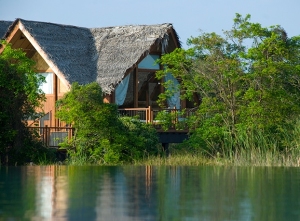Riding Sri Lanka’s new wave
by Jetwing · Published · Updated

Surfers in the remote coastal town of Arugam Bay, Sri Lanka. (Kieran Nash)
There are not many places on Earth where travellers can surf world-class waves in the morning, have a close encounter with an elephant at lunchtime and be back in the water by mid afternoon. Arugam Bay, on Sri Lanka’s eastern coast, is one such place, and since the country’s civil war ended three years ago, the small town has been busier than ever – despite how hard it is to get to.
Other than a highway from Colombo, the capital, to Galle, a city in the south, most of Sri Lanka’s roads remain practically as they were in the 1950s – which means narrow, dual carriageways shared by everyone, including cyclists, buses and trucks. As such, the coast-to-coast haul from Colombo to Arugam Bay by public bus is a 400-rupee, 320km journey that takes nearly 12 hours. It is hot, uncomfortable, occasionally terrifying and utterly worthwhile.
On a recent trip, a young man with an AK-47 boarded the noisy bus and prodded the barrel of his assault rifle into the belly of a middle-aged woman. Rather than panic and scream, she politely asked him to refrain, and the young man, a soldier in the Sri Lankan army, looked a bit embarrassed and apologised. The weapon, hanging from his shoulder, had accidentally prodded the woman as he leaned forward to stow his luggage in the cramped overhead compartment.
Well-marked busses leave frequently from the Bastian Mawatha Bus Terminal in Colombo. Alternatively, visitors can make the journey by taxi, which will take less time and has the added bonus of privacy and air-conditioning, but will cost about 16,500 rupees.
Once you get to Arugam Bay, there is not much to do. The town – nicknamed “A Bay” by locals – is basically a thin strip of road with bars and restaurants frequented by young surfers and partygoers, a smattering of places to stay, a few surf shops and not much else, but travellers are lured by the excellent food on offer, easy access to exotic wildlife and waves that are widely regarded as some of the country’s best. It seems like a place on the cusp of something, which, in a way, it is. Many of the local tourism operators, tuk-tuk drivers and restaurant staff say that 2012 has been the busiest year yet.
The hometown surfers have grown up on Arugam Bay’s many breaks, and run the town’s surf shops and schools. Safa surf shop (Main Street; 94-779-552-268) has a wide range of boards for hire, from high-performance shortboards for the more experienced, to large, stable longboards for beginners. The owner, Fawas Lafeer, or another of Safa’s friendly, competent instructors can recommend the best board to suit a visitor’s level of experience.
The next morning, as the sun was just hauling itself over the horizon, Lafeer and I decided to test out Arugam Bay’s main surf break, Main Point. As the rising sun cast an amber haze over the spray, a quick walk from Ranga’s Beach Hut brought us to the break – a fantastically easy-to-surf right-hand wave, breaking over a fairly soft reef before wrapping around the point, where it got smaller and easier for the less experienced surfers in the line-up. On a good day, rides of 500m are not uncommon. As can be expected with famous breaks such as this, the crowds were out – much of it made up with Italian and Israeli surfers.
For the crowd-averse, or those wanting smaller waves, there are other options within, at most, a 30-minute half-hour tuk-tuk ride of Arugam Bay. Pottuvil Point, an 8km drive north, is a lot smaller and easier on the learners. Whiskey Point, about 14km north, offers more high-quality waves than Pottuvil Point, fewer crowds and is the number one party beach on a Friday night. Peanut Farm, located 6km south of Arugam Bay, offers small waves similar to Pottuvil Point, and Crocodile Rock, 8km south of Arugam Bay, is another ideal spot for novices. It is named after the reptiles which frequent the beach’s lagoon (thankfully far from the surfer’s waves), and any tuk-tuk driver worth their salt will know the best time to catch the crocs bathing.
Source: http://www.bbc.com/travel/feature/20130111-riding-sri-lankas-new-wave



